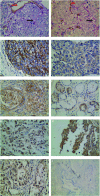[Expression of CD82/KAI1 and HIF-1α in non-small cell lung cancer and their relationship to vasculogenic mimicry]
- PMID: 22152691
- PMCID: PMC6000186
- DOI: 10.3779/j.issn.1009-3419.2011.12.04
[Expression of CD82/KAI1 and HIF-1α in non-small cell lung cancer and their relationship to vasculogenic mimicry]
Abstract
Background and objective: Vasculogenic mimicry (VM), found in many high invasive ability tumors, is associated with tumor invasion and metastasis. Many genes exhibit abnormal levels of expression in these tumors. This study aims to find good markers for predicting the invasion and metastasis of non-small cell lung cancer (NSCLC).
Methods: VM and expression of CD82/KAI1 and HIF-1α were examined via immunohistochemistry and histochemistry of 160 NSCLC and 20 normal lung tissue specimens.
Results: In NSCLC, positive rates of 37.5%, 48.8%, and 36.9% were obtained for CD82/KAI1, HIF-1α, and VM, respectively. In normal lung tissue, positive rates of 95.0%, 0, and 0 were obtained for CD82/KAI1, HIF-1α, and VM, respectively. A significant difference was found between the NSCLC and normal lung groups (P<0.01). VM and the expression levels of CD82/KAI1 and HIF-1α were significantly related to tumor differentiation, lymph node metastasis, clinical staging, and postoperative survival time (P<0.01 for all). A negative correlation was found between the expression levels of CD82/KAI1 and HIF-1α; a similar relationship was observed between CD82/KAI1 and VM. A positive relationship between the expression of HIF-1α and VM was revealed; there was a significant relationship between microvessel density (MVD) and the expression of CD82/KAI1 or HIF-1α or VM. VM and overexpression of HIF-1α were related to poor prognosis: the survival rates were significantly lower in positive patients than in negative patients (both P<0.01). The survival rates of the CD82/KAI1-positive and CD82/KAI1-negative groups were significantly different (P<0.01). The five-year survival rate was significantly different between the group with MVD≥22 and the group with MVD<22 (P<0.01). pTNM stage, positive expressions of CD82/KAI1 and HIF-1α, and VM were independent prognostic factors of NSCLC (P<0.01).
Conclusions: VM and the expressions of CD82/KAI1 and HIF-1α in NSCLC are related to differentiation, lymph node metastasis, clinical staging, and prognosis. The combined detection of CD82/KAI1, HIF-1α, and VM has an important role in predicting the progression and prognosis of NSCLC.
背景与目的: 新近研究显示血管生成拟态存在于多种高侵袭性肿瘤中, 并与肿瘤细胞的侵袭、转移特性有关, 在形成血管生成拟态的肿瘤中有多种基因表达异常。本研究旨在寻找能预测非小细胞肺癌(non-small cell lung cancer, NSCLC)浸润、转移及术后生存率的指标。
方法: 采用免疫组化ElivisionTM plus法和特殊组织化学法检测160例NSCLC和20例正常肺组织中缺氧诱导因子-1α(hypoxia inducible factor-1α, HIF-1α)、CD82/KAI1的表达和血管生成拟态(vasculogenic mimicry, VM)情况。
结果: 在正常肺组织中HIF-1α、CD82/KAI1的表达率和VM分别为0、95.0%和0, 在NSCLC组织中分别为48.8%、37.5%和36.9%, 差异有统计学意义(P < 0.01);其水平与肿瘤细胞分化程度、淋巴结转移、临床分期和术后生存期有关(P < 0.01);CD82/KAI1的表达与HIF-1α的表达以及VM呈负相关, HIF-1α的表达水平与VM呈正相关(P < 0.05);CD82/KAI1、HIF-1α的表达以及VM均与微血管密度(microvessel density, MVD)有关联性(P < 0.01)。Kaplan-Meier生存分析表明HIF-1α的过表达和VM均与患者的生存率有关, 阳性的患者生存率明显低于阴性者(P < 0.01);而CD82/KAI1阳性表达的患者生存率明显高于阴性者(P < 0.01);MVD≥22的5年生存率明显低于MVD < 22的生存率(P < 0.01)。多因素分析:pTNM分期、CD82/KAI1、HIF-1α的表达以及VM是影响NSCLC根治术后患者预后的独立因素(P < 0.01)。
结论: CD82/KAI1、HIF-1α在NSCLC组织中的表达水平以及VM与肿瘤的分化程度、转移和预后等均有关, CD82/KAI1、HIF-1α和VM联合检测对NSCLC的进展及预后判断有重要意义。
Figures


References
-
- Muneyuki T, Watanabe M, Yamanaka M, et al. KAI1/CD82 expression as a prognostic factor in sporadic colorectal cancer. https://ynu.pure.elsevier.com/en/publications/kai1cd82-expression-as-a-p... Anticancer Res. 2001;21(2):3581–3587. - PubMed
-
- Kumada T, Tsuneyama K, Hatta H, et al. Improved 1-h rapid immunostaining method using intermittent microwave irradiation:practicability based on 5 years application in Toyama Medical and Pharmaceutical University Hospital. Mod Pathol. 2004;17(9):1141–1149. doi: 10.1038/modpathol.3800165. - DOI - PubMed
-
- Vartanian A, Baryshnikov AY. Crosstalk between apoptosis and antioxidants in melanoma vasculogenic mimicry. https://link.springer.com/content/pdf/10.1007/978-0-387-72005-0_15.pdf. Adv Exp Med Biol. 2007;601(4):145–153. - PubMed
MeSH terms
Substances
LinkOut - more resources
Full Text Sources
Medical

